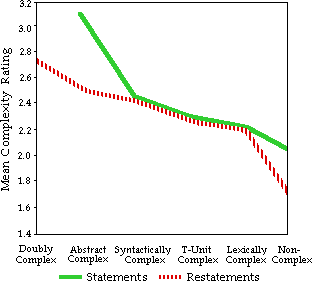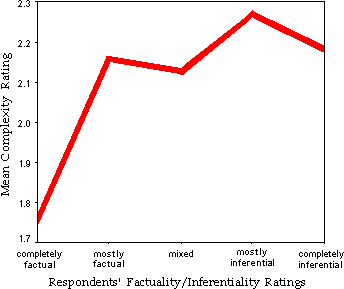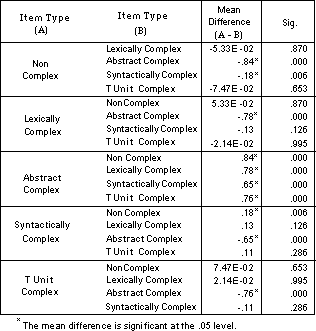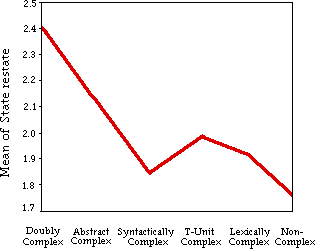The first part of this article, online at www.jalt.org/test/haj_1.htm, introduced several factors
thought to influence reading comprehension. This section shows how a test investigating
judgments about reading complexity was developed, validated, and utilized.
Method
 A convenience sample of 99 senior English majors at three universities in Tehran participated in this study. Fifty of the respondents were males and 49 were females.
A convenience sample of 99 senior English majors at three universities in Tehran participated in this study. Fifty of the respondents were males and 49 were females.
 In Phase 1 of this study, respondents had 120 minutes to rate 55 statements according to six different scales. These statements,
which are online at www.jalt.org/test/haj_p1_0.htm, were rated according to the following criteria: general complexity, imagery, lexical
difficulty, world knowledge demand, semantic complexity, and syntactic complexity. All statements were seventeen words in length.
In Phase 1 of this study, respondents had 120 minutes to rate 55 statements according to six different scales. These statements,
which are online at www.jalt.org/test/haj_p1_0.htm, were rated according to the following criteria: general complexity, imagery, lexical
difficulty, world knowledge demand, semantic complexity, and syntactic complexity. All statements were seventeen words in length.
 Five types of statements were examined in Phase 1:
Five types of statements were examined in Phase 1:
- Non-complex statements - with a low lexical density, high
degree of imagery, single clause T-unit constructions, and no
topicalization or pseudo-cleft.
- Lexically dense statements - which resembled the
previous statements, except for a high lexical density.
- Syntactically complex statements - which were like
non-complex statements, but with topicalization and pseudo-cleft.
- T-unit complex statements - which were similar to non-complex
statements, except they contained two subordinate and one main clause.
- Abstract statements - with the characteristics of the
non-complex sentences, but less imagery.
 If respondents felt unsure how to rate a statement, they were instructed to leave it blank.
If respondents felt unsure how to rate a statement, they were instructed to leave it blank.
 In Phase 2 of this study, administered one week later, respondents had
100 minutes to rate the 55 restatements online at www.jalt.org/test/haj_p2_0.htm
according to the same scales used in Phase 1. Again, if respondents felt unsure how to rate an item, they were instructed
to leave it blank.
In Phase 2 of this study, administered one week later, respondents had
100 minutes to rate the 55 restatements online at www.jalt.org/test/haj_p2_0.htm
according to the same scales used in Phase 1. Again, if respondents felt unsure how to rate an item, they were instructed
to leave it blank.
 All restatements were eleven words in length and organized into six
categories. In addition to the five categories explored in Phase 1,
doubly complex restatements were examined. Doubly complex
restatements combined two forms of complexity, such as abstractness and
T-unit complexity. Hence the statements in Phase 1 differed from
the restatements in Phase 2 in two ways: (1) the restatements were
slightly shorter, and (2) some restatements combined two forms of complexity.
All restatements were eleven words in length and organized into six
categories. In addition to the five categories explored in Phase 1,
doubly complex restatements were examined. Doubly complex
restatements combined two forms of complexity, such as abstractness and
T-unit complexity. Hence the statements in Phase 1 differed from
the restatements in Phase 2 in two ways: (1) the restatements were
slightly shorter, and (2) some restatements combined two forms of complexity.
 In Phase 3 of this study, administered a week after the second phase,
respondents were given as much time as they needed to assess the 55
statements of Phase 1 along with the 55 restatements used in
Phase 2 according to seven scales. In addition to the six scales used
in the first two phases of this study, respondents evaluated
statements/restatements according to a five point scale of
factuality/inferentiality, then decided whether the restatements seemed true.
In Phase 3 of this study, administered a week after the second phase,
respondents were given as much time as they needed to assess the 55
statements of Phase 1 along with the 55 restatements used in
Phase 2 according to seven scales. In addition to the six scales used
in the first two phases of this study, respondents evaluated
statements/restatements according to a five point scale of
factuality/inferentiality, then decided whether the restatements seemed true.
 All statements and restatements were paired into a
"stem-response" format. In a stem-response format, the second
statement depends on the statement preceding it. A sample
stem-response pair for one item from Phase 3 of this study appears below -
All statements and restatements were paired into a
"stem-response" format. In a stem-response format, the second
statement depends on the statement preceding it. A sample
stem-response pair for one item from Phase 3 of this study appears below -
[
p. 7
]
Stem: The old Japanese driver finally parked his small car between the toy shop and the grocery store.
Response: The driver took some time to park his car over there.
Degree of Factuality / Inferentiality:
1 2 3 4 5
completely mostly evenly mostly completely
factual factual mixed inferential inferential
Response Veracity:
TRUE / FALSE
(Instruction: If the response does not appear to be necessarily true, please select false.)
|
 If respondents were unsure how to rate a stem-response pair, they were instructed to leave it blank.
The full survey is online at www.jalt.org/test/haj_p3_0.htm.
If respondents were unsure how to rate a stem-response pair, they were instructed to leave it blank.
The full survey is online at www.jalt.org/test/haj_p3_0.htm.
Results and Discussion
 This study explores five research questions, three of which will be considered in this segment:
This study explores five research questions, three of which will be considered in this segment:
- Are respondents able to distinguish between different kinds of complexity?
- Do respondents assign significantly differentiated item complexity orders on the basis of the statement/restatement types?
- How do factuality/inferentiality ratings by respondents pertain to item complexity ratings?
 The raw data used in this survey is online at www.jalt.org/test/haj_a2.htm.
Let us now begin our investigation.
The raw data used in this survey is online at www.jalt.org/test/haj_a2.htm.
Let us now begin our investigation.
Question 1: Are respondents able to distinguish between different kinds of complexity?
|
 Except for two data types, the answer to this question is "yes".
Although the respondents did not distinguish (1) lexically complex
sentences from T-unit complex sentences, or (2) syntactically complex
sentences from T-unit complex sentences in any statistically
significant way, they did distinguish these types
of data at a P <.05 level of significance:
Except for two data types, the answer to this question is "yes".
Although the respondents did not distinguish (1) lexically complex
sentences from T-unit complex sentences, or (2) syntactically complex
sentences from T-unit complex sentences in any statistically
significant way, they did distinguish these types
of data at a P <.05 level of significance:
[
p. 8
]
non-complex
non-complex
non-complex
non-complex
lexically complex
lexically complex
abstract complex
abstract complex
|
from
from
from
from
from
from
from
from
|
lexically complex
abstract complex
syntactically complex
T-unit complex
abstract complex
syntactically complex
syntactically complex
T-unit complex
|
 Let's consider how this point is illustrated in Phase 1 of this study.
Cross-tabulations revealed that subjects rated abstract complex
statements as being most difficult and non-complex statements least
difficult. A summary of the different types of complexity ratings
for Phase 1 of this study appears below:
Let's consider how this point is illustrated in Phase 1 of this study.
Cross-tabulations revealed that subjects rated abstract complex
statements as being most difficult and non-complex statements least
difficult. A summary of the different types of complexity ratings
for Phase 1 of this study appears below:
1. Abstract complex
2. Syntactically complex
3. T-unit complex
4. Lexically complex
5. Non-complex
|
Mean
3.11
2.46
2.33
2.25
2.07
|
S.D.
1.22
1.20
1.16
1.17
1.10
|
Table 1. Mean general complexity ratings for five statement types found at www.jalt.org/test/haj_p1_0.htm
according to a 5-point scale in which "5" denotes very complex and "1" very simple.
 To further analyze this question, an ANOVA was performed on
the complexity ratings of the 55 restatements in Phase 2. The
respondents distinguished the same sentence types in this
phase as in the previous phase. In addition, they also distinguished these sentence
types a P < .05 level of significance:
To further analyze this question, an ANOVA was performed on
the complexity ratings of the 55 restatements in Phase 2. The
respondents distinguished the same sentence types in this
phase as in the previous phase. In addition, they also distinguished these sentence
types a P < .05 level of significance:
doubly complex
doubly complex
doubly complex
doubly complex
|
from
from
from
from
|
non-complex
abstract complex
syntactically complex
from T-unit complex
|
 The only sentence types they were not able to distinguish were,
as in Phase 1, (1) T-unit complex ones from lexically complex ones,
and (2) abstract complex ones from syntactically complex ones.
The only sentence types they were not able to distinguish were,
as in Phase 1, (1) T-unit complex ones from lexically complex ones,
and (2) abstract complex ones from syntactically complex ones.
 How did the respondents rate the six restatement types in
terms of complexity? The complexity ratings are summarized
in Table 2 below -
How did the respondents rate the six restatement types in
terms of complexity? The complexity ratings are summarized
in Table 2 below -
1. Doubly complex
2. Abstract complex
3. Syntactically complex
4. T-unit complex
5. Lexically complex
6. Non-complex
|
Mean
2.76
2.45
2.43
2.22
2.21
1.62
|
S.D.
1.23
1.17
1.20
1.12
1.19
.94
|
Table 2. Mean general complexity ratings for six restatement types
found at www.jalt.org/test/haj_p2_0.htm
according to a 5-point scale in which "5" denotes very complex and "1" very simple.
[
p. 9
]
 To clarify how these two data sources differ, note how the mean values
for each sentence type explored in the first two phases of this study differ -
To clarify how these two data sources differ, note how the mean values
for each sentence type explored in the first two phases of this study differ -

Figure 1. Mean general complexity ratings for five statement types
(solid line) explored in Phase 1 and six restatement types (dotted line)
explored in Phase 2 of this study according to a 5-point scale.
 Table 1 and 2 suggest that respondents rated sentences in terms of the
following descending hierarchy of complexity:
Table 1 and 2 suggest that respondents rated sentences in terms of the
following descending hierarchy of complexity:
1. Doubly complex
2. Abstract complex
3. Syntactically complex
4. T-unit complex
5. Lexically complex
6. Non-complex
|
Question 2: Do respondents assign significantly differentiated item complexity orders
on the basis of the statement/restatement types?
|
 Generally, the hierarchy of complexity suggested in Question 1 was
also found in the item complexity ratings in Phase 3. Whereas Question 1
relied on data from Phase 1 and 2 of this study, this question
employed data from Phase 3. The restatement types found in the
"response" of each of the paired sentences at www.jalt.org/test/haj3_0.htm
were considered as independent variables in a one-way ANOVA. In this
ANOVA, the dependent variable was the general complexity ratings for Phase 3,
which are online at www.jalt.org/test/haj3_1.htm. The main hunch
pushing me toward this question was that respondents might rate
stem-response complexity by paying predominant attention to the
stem rather than both sentences in the whole item. Or, the other way
round, they might pay special attention to the response in deciding
how complex an item was. Table 3 summarizes the ANOVA ratings:
Generally, the hierarchy of complexity suggested in Question 1 was
also found in the item complexity ratings in Phase 3. Whereas Question 1
relied on data from Phase 1 and 2 of this study, this question
employed data from Phase 3. The restatement types found in the
"response" of each of the paired sentences at www.jalt.org/test/haj3_0.htm
were considered as independent variables in a one-way ANOVA. In this
ANOVA, the dependent variable was the general complexity ratings for Phase 3,
which are online at www.jalt.org/test/haj3_1.htm. The main hunch
pushing me toward this question was that respondents might rate
stem-response complexity by paying predominant attention to the
stem rather than both sentences in the whole item. Or, the other way
round, they might pay special attention to the response in deciding
how complex an item was. Table 3 summarizes the ANOVA ratings:

Table 3. Mean differences for the complexity ratings for items in
Phrase 3 of this study on the basis of the five statement types.
[
p. 10
]
 To make sure that Table 3 is clear, let us point out that "mean difference" refers to the
difference between the mean of one variable from that of another. For
example, the mean difference between non-complex statements and
abstract complex ones was -.84. This means that most
non-complex statements were .84 points less complex than abstract
complex statements. Moreover, the * mark denotes statistically significant differences
at a P< 0.05 level, meaning that the result cannot be ascribed to
random accident in 95% of the cases.
To make sure that Table 3 is clear, let us point out that "mean difference" refers to the
difference between the mean of one variable from that of another. For
example, the mean difference between non-complex statements and
abstract complex ones was -.84. This means that most
non-complex statements were .84 points less complex than abstract
complex statements. Moreover, the * mark denotes statistically significant differences
at a P< 0.05 level, meaning that the result cannot be ascribed to
random accident in 95% of the cases.
 The mean differences for the various item types in this study can
also be expressed in Fig. 2:
The mean differences for the various item types in this study can
also be expressed in Fig. 2:

Figure 2. Means plot of item complexity ratings on the basis of five item types.
 Figure 2 suggests that there is a meaningful parallel between item
complexity judgments and statement complexity judgments if statement
types are considered as independent variables. The hierarchy of
complexity suggested in Question 1 also holds here.
Figure 2 suggests that there is a meaningful parallel between item
complexity judgments and statement complexity judgments if statement
types are considered as independent variables. The hierarchy of
complexity suggested in Question 1 also holds here.
 As observed, some pairs have significant differences while others do
not. To a large extent, this is because deciding item complexity may
not, in reality, take place merely on the basis of the statement type.
Herein, we have to consider the fact that subjects might also attend
to each sentence-level statement. The interaction between the
statements and restatements also need to be considered.
As observed, some pairs have significant differences while others do
not. To a large extent, this is because deciding item complexity may
not, in reality, take place merely on the basis of the statement type.
Herein, we have to consider the fact that subjects might also attend
to each sentence-level statement. The interaction between the
statements and restatements also need to be considered.
 To further explore Question 2, a ANOVA was performed with the
restatement types from Phase 2 as independent variables and
general complexity ratings for items in Phase 3 as the dependent
variable. The results appear in Table 4.
To further explore Question 2, a ANOVA was performed with the
restatement types from Phase 2 as independent variables and
general complexity ratings for items in Phase 3 as the dependent
variable. The results appear in Table 4.

Table 4. Mean differences of item complexity ratings on the basis of the six restatement types in Phase 2 of
this study.
[
p. 11
]
 An interesting point is the similarity between the pattern
observed in this analysis and the one for restatement complexity
considering restatement types, which is depicted in Figure 3.
An interesting point is the similarity between the pattern
observed in this analysis and the one for restatement complexity
considering restatement types, which is depicted in Figure 3.

Figure 3. Means plot of item complexity ratings on the basis
of the 6 restatement types from Phase 2.
 Although there are minor changes in this pattern, there is a meaningful
parallel between item complexity judgments and restatement complexity
judgments if we consider restatement types as independent variables.
Doing this, the following hierarchy of complexity is manifest:
Although there are minor changes in this pattern, there is a meaningful
parallel between item complexity judgments and restatement complexity
judgments if we consider restatement types as independent variables.
Doing this, the following hierarchy of complexity is manifest:
1. Doubly complex
2. Abstract complex
3. T-unit complex
4. Lexically complex
5. Syntactically complex
6. Non-complex
|
 The only difference between the hierarchy above and the one suggested
earlier is a decrease of syntactically complex ratings.
The only difference between the hierarchy above and the one suggested
earlier is a decrease of syntactically complex ratings.
 Question 2 corroborates the findings of Question 1, which suggest
that respondents consider a hierarchy of complexity. This hierarchy
is manifested even when we have a combination of various statement and
restatement types. One possible justification for the findings of
Question 2 is that respondents decided on item general complexity
mainly on the basis of a simple addition of the features of statements
and restatements rather than paying attention to the pragmatic
interaction of both parts of each item.
Question 2 corroborates the findings of Question 1, which suggest
that respondents consider a hierarchy of complexity. This hierarchy
is manifested even when we have a combination of various statement and
restatement types. One possible justification for the findings of
Question 2 is that respondents decided on item general complexity
mainly on the basis of a simple addition of the features of statements
and restatements rather than paying attention to the pragmatic
interaction of both parts of each item.
Question 3: How do factuality/inferentiality ratings by respondents
pertain to item complexity ratings?
|
 The data from Phase 3 suggests that a parallel exists between how
complex respondents perceive an item to be and how factual or
inferential they perceive it to be. Respondents generally considered
factual items to be simpler than inferential ones. Let us summarize
the complexity ratings for the 55 "stem-response" pairs examined
in the final phase of this study:
The data from Phase 3 suggests that a parallel exists between how
complex respondents perceive an item to be and how factual or
inferential they perceive it to be. Respondents generally considered
factual items to be simpler than inferential ones. Let us summarize
the complexity ratings for the 55 "stem-response" pairs examined
in the final phase of this study:
1. Completely factual
2. Mostly factual
3. Equally mixed
4. Mostly inferential
5. Completely inferential
6. No response
|
Mean
1.76
2.16
2.12
2.27
2.18
***
|
S.D.
.92
.95
1.01
.99
1.17
****
|
% of Total Items
26.9% (N = 1467)
13.4% (N = 730)
9.6% (N = 526)
9.4% (N = 516)
17.4% (N = 951)
23.0% (N = 1255)
|
Table 5. Mean complexity ratings for paired "stem-response" statements/restatements
found at www.jalt.org/test/haj_p3_0.htm by 99 respondents in this study.
[
p. 12
]
As you can see, respondents tended to consider the following pairs
significantly different in terms of general complexity -
completely factual items
completely factual items
completely factual items
completely factual items
|
from
from
from
from
|
mostly factual items
equally mixed items
mostly inferential items
completely inferential items
|
 Completely factual items were rated as the
easiest item types. Looking at the data on Table 3, what is
especially significant is that completely factual items were
rated much easier than items which were either mostly or entirely
inferential. This suggests that respondents recognized a parallel
between perceived complexity and perceived factuality/inferentiality.
Completely factual items were rated as the
easiest item types. Looking at the data on Table 3, what is
especially significant is that completely factual items were
rated much easier than items which were either mostly or entirely
inferential. This suggests that respondents recognized a parallel
between perceived complexity and perceived factuality/inferentiality.
Final Episode
 In the next part of this article we will explore
the way stem-response combinations appear to influence complexity
order rankings, and how complexity ratings by students differ from
those of teachers. Some of the practical implications of this study
will also be underscored.
In the next part of this article we will explore
the way stem-response combinations appear to influence complexity
order rankings, and how complexity ratings by students differ from
those of teachers. Some of the practical implications of this study
will also be underscored.





